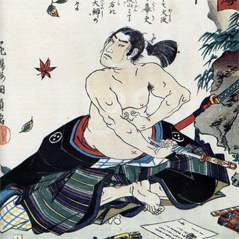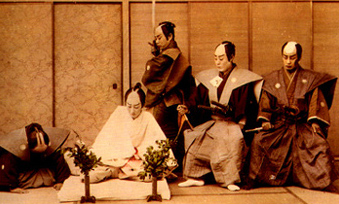|
Suemono Giri: Clarification of an Old Tradition
|
Fujiyama Dojo P.O. Box 20003 Thorold, ON, Canada L2V 5B3 (905) 680-6389 |
|---|
 Of all traditions of ko ryu bujutsu, suemono giri techniques of the kaishaku soden, are the most misunderstood. We will make no attempt to justify its practice, but we will try to explain their origins and meaning, in the hopes of responding to some of the negative comments expressed against them. Of all traditions of ko ryu bujutsu, suemono giri techniques of the kaishaku soden, are the most misunderstood. We will make no attempt to justify its practice, but we will try to explain their origins and meaning, in the hopes of responding to some of the negative comments expressed against them.
Historical Background
Suemono giri techniques originated with the practice of testing sword blades on the bodies of condemned criminals, or corpses of enemies, to test the precision of a cut. The Kaishaku (Kaishakunin) was a swordsman aiding in ritual suicide (seppuku, or hara-kiri). His role was to sever the head of the person committing suicide. His skill had to be of the highest level, since his sword cut had to be quick, clean and precise. The mark of a Kaishakunin was his flawless technique, which guaranteed a merciful death. The speed and precision of his cut ensured a smooth ending to the very painful ceremony. A swordsman worthy of the position of Kaishaku was a man of exceptional skill, control and character. The immutability of his spirit was another trait of the swordsman selected for this role. Each clan usually appointed an official Kaishakunin, who enjoyed the privileges of a high-ranked samurai, which were extended to his immediate family. The training of the Kaishakunin involved suemono giri. Besides the customary matches to decide the most suitable candidate, suemono giri demonstrations were used to prove the samurai's ultimate skill. A true Kaishakunin's beheading sword cut should be virtually painless. His spirit and conduct had to abide by what is called Go-Jo or the five main Conditions: Virtue, Justice, Etiquette, Wisdom, and Truth. The Kaishakunin
The techniques of the kaishaku soden are, of course, concealed. The section involving taijutsu required a high level of mastery. Those involving the sword were considered to be the application of all previous knowledge, where oyo(application) is already fully understood and achieved. This level(known sometimes as kufu-den) separated the common swordsman from the master swordsman, which a Kaishakunin had to be, since the knowledge he received was then instinctive. The Kaishakunin was defined as "the proven man". The Aizu clan Kaishaku scroll offers some advice to the Kaishakunin that serves as insights for life. Two of these are: "Give the enemy no face", recommending unemotional response to attacks. "Mercy bears no reasoning", teaching mercy for mercy's sake. The Kaishakunin has been incorrectly defined in various texts as an assassin. In truth, he was far from being a hired killer in that context. The term executioner brings to mind the hooded medieval, often axe-wielding image that bears very little resemblance to the true Kaishakunin. Although his position required him to have exceptional skills, his function had more to do with mercy, and with the etiquette of death, so to speak, than with actual killing. His job was to end pain with a flawless and merciful technique. The Tradition
 Suemono giri, and other sections of the kaishaku soden, are not the morbid tradition of killing sometimes described in contemporary books and magazines dealing with, but not understanding, ko ryu bujutsu.
Aloof, scholarly works, sometimes failing to comprehend the tradition, trample all over it with rationalizations ranging from the apathetic to the cynical. Other more commercially minded embellish the truth, portraying spectacular techniques, (the true techniques are quite subdued), or fierce intent(nothing farther from the truth), and glamorizing the individual, who rather than being a super-human warrior, was nothing more than a man who trained hard and lived a disciplined life.
The techniques learned at this level are by no means violent, inhumane or any different ethically from any other in traditional styles. Today the blade slices through straw and bamboo, not flesh, but the "five conditions" are still a requirement. Suemono giri remains a test of skill. Most classical styles that developed within particular clan keep the tradition and level of Kaishaku, which is not the perpetuation of a tradition of looking at death with contempt, but a tradition of life. Those unable to realize this have yet to understand ko ryu bujutsu. Suemono giri, and other sections of the kaishaku soden, are not the morbid tradition of killing sometimes described in contemporary books and magazines dealing with, but not understanding, ko ryu bujutsu.
Aloof, scholarly works, sometimes failing to comprehend the tradition, trample all over it with rationalizations ranging from the apathetic to the cynical. Other more commercially minded embellish the truth, portraying spectacular techniques, (the true techniques are quite subdued), or fierce intent(nothing farther from the truth), and glamorizing the individual, who rather than being a super-human warrior, was nothing more than a man who trained hard and lived a disciplined life.
The techniques learned at this level are by no means violent, inhumane or any different ethically from any other in traditional styles. Today the blade slices through straw and bamboo, not flesh, but the "five conditions" are still a requirement. Suemono giri remains a test of skill. Most classical styles that developed within particular clan keep the tradition and level of Kaishaku, which is not the perpetuation of a tradition of looking at death with contempt, but a tradition of life. Those unable to realize this have yet to understand ko ryu bujutsu.
|
|---|


